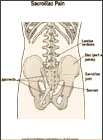
Sacroiliac Pain
What is the sacroiliac joint?
The sacroiliac joint is the part of your lower back made up of the sacrum (the bony structure above your tailbone and below your lower vertebrae) and the top part (iliac) of your pelvis. It is the part of the low back just behind your waist. You have right and left sacroiliac joints. Ligaments hold these bones in place.
How does sacroiliac joint pain occur?
Some possible causes of sacroiliac pain include:
- activities that involve twisting, bending, or heavy lifting (for example, swinging a golf club or shoveling)
- a fall or a direct blow to the area
- imbalance of the muscles around your hip or pelvis from one leg being shorter or longer than the other
- poor posture
- ligaments in the sacroiliac joint that are too loose.
What are the symptoms?
Symptoms can include:
- pain in the sacroiliac area of the low back
- difficulty bending or twisting your low back
- pain after sitting for a long time
- stiffness in the low back, hip, or leg
- a feeling of being "out of alignment."
How is it diagnosed?
Your provider will ask about your health history and examine your back, pelvis, hips, and legs. You may need an x-ray, or in some cases a CT scan or an MRI. These tests are done to rule out other causes of pain.
How is it treated?
For the first 2 to 3 days you should treat the area with ice packs for 20 to 30 minutes every 4 to 6 hours. You may use a frozen gel pack, crushed ice, or a bag of frozen peas. After icing for a few days, you may start to use moist heat to help loosen up a stiff sacroiliac joint and the muscles of your lower back.
Other treatments may include:
- anti-inflammatory medication, muscle relaxants, or other medication
- exercises
- massage to your low back and sacroiliac joint
- physical therapy
- mobilization of the sacroiliac joint (A physical therapist, chiropractor, or a physician trained in manipulative medicine may do this. This is done by applying force across the joint and helping put the joint in better alignment.)
- an insert for your shoe, if your legs are different lengths
- a sacroiliac belt which will help support the joint
- a cortisone injection into the sacroiliac joint to reduce pain and swelling.
When can I return to my sport or activity?
The goal of rehabilitation is to return you to your sport or activity as soon as is safely possible. If you return too soon you may worsen your injury, which could lead to permanent damage. Everyone recovers from injury at a different rate. Return to your sport or activity will be determined by how soon your sacroiliac joint recovers, not by how many days or weeks it has been since your injury occurred. In general, the longer you have symptoms before you start treatment, the longer it will take to get better.
It is important that you have fully recovered from your sacroiliac pain before you return to your sport or any strenuous activity. You must be able to have the same range of motion that you had before the injury. You must be able to twist, bend, run and jump without pain.
How is sacroiliac pain prevented?
Be sure that you have warmed up and have done proper stretching exercises before participating in sports or other activities. Try not to twist when you are lifting heavy objects.

